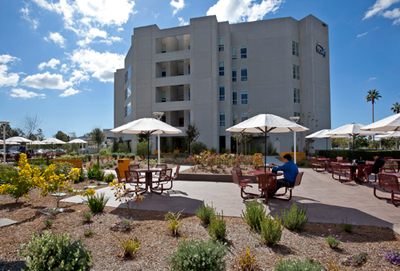Healing Design: Therapeutic Landscapes in Orange County
Last year, we sent one of our brightest landscape designers to study Therapeutic Landscape Design for a week, at the Chicago Botanic Gardens. If you remember, this is part of the LPA Travel and Training Grant program—funded solely from reward money from Savings by Design (i.e. we get incentive money, for making our building’s as energy efficient as possible, which we’d do anyway, and use the incentives to fund continuing educational experience for our employees). It’s a win, win, win.
With the opening of Hoag Hospital Irvine, where we implemented this idea of healing landscape design, there has been a lot of interest in this topic. We decided to interview Jessie Craven, and pepper her with questions about her studies and practice of Therapeutic Landscape Design and Healing Gardens.
JESSIE CRAVEN, LEED AP
Q. You mention horticultural therapy in the video above. Can you tell us more about it?
A. Horticultural therapy is very beneficial to all different types of patients. Being outdoors causes blood pressure and stress levels to drop almost immediately, which aids people in physical healing. Being in nature also helps people heal mentally—seeing life in gardens such as birds, bees and butterflies, as well as the plants themselves, often gives people a sense of hope and perspective.
If patients can do activities outdoors, such as planting or taking care of plants, this also can aid in their physically recovery by exercising fine motor skills and working to regain range of motion by bending, sitting or standing to do their work. This type of work is not only beneficial to patients in a hospital but also for people dealing with everyday life. Interestingly enough, gardening and bird watching are noted as the top two American hobbies, which speaks to the fact that they have some enjoyable or healing qualities.
Q. How can nature deficit disorder be alleviated?
A. It is imperative for children to have access to nature. With modern technologies, it’s increasingly easier for children to sit and play video games or surf the internet, thus creating a disconnect from the natural world. Places like the Environmental Nature Center in Newport Beach, which offer nature programs and camps for children, are great places to experience and learn about nature. At LPA, we do our best to create environments that have comfortable and interesting outdoor spaces for users to enjoy. Helping children to understand and respect our environment strengthens their land stewardship in the future, and hopefully, helps their kids, avoid nature deficit disorder all together.
 Q. How does one balance sustainable landscapes with healing landscapes?
Q. How does one balance sustainable landscapes with healing landscapes?
A. Sustainable landscapes and healing landscapes go hand in hand. Creating diverse landscapes by incorporating varied plantings that attract wildlife suit sustainable and healing landscapes perfectly. Certain LEED credits show us this by requiring views out of buildings, adding trees to offset heat island effects, and by requiring a certain percentage of landscaped area, on any given project.
Q. How can health and wellness be incorporated into our landscape designs?
A. By continuing to create sustainable buildings and landscapes, we craft healthy places for people to work, live and play. Making outdoor environments accessible and inviting by adding elements such as walking paths and richly planted landscapes, encourages people to get out and connect with nature. It’s a very natural, organic process.
Jessie Craven is a landscape designer and project coordinator with California-based LPA Inc. She has worked on several award winning landscapes, with an emphasis on government and community facilities. Craven is a LEED Accredited Professional and active member of the U.S. Green Building Council.